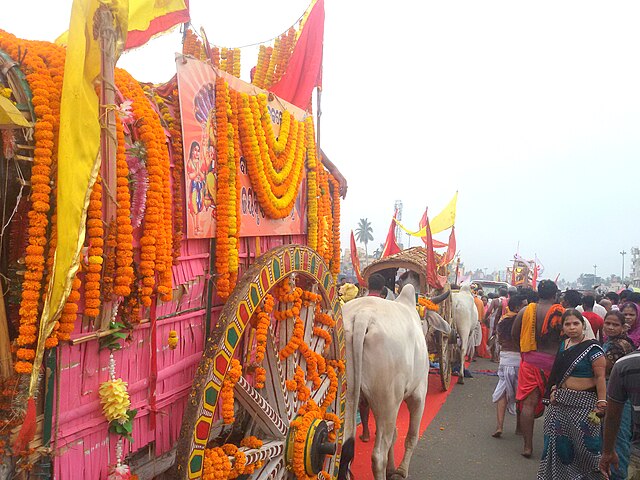The Ratha Yatra of Puri, also rendered as the Ratha Jatra, is considered the oldest and largest Hindu chariot festival celebrated annually, on the bright half of the lunar month of Ashadh (June–July). The festival is held at the city of Puri, in the state of Odisha, India and associated with the deity Jagannath. During the festival, three deities are drawn by a multitude of devotees in three massive, wooden chariots on bada danda to Gundicha Temple whereby they reside there for a week and then return to the Jagnannath temple. This return trip is referred to as the Bahuda Yatra.
Three chariots of the deities with the temple in the background, Puri
Nandighosa Ratha during Covid-19 Ratha Yatra
Chariot is under construction
Pahandi of Jagannath during Rathajatra 2017.
Jagannatha is a deity worshipped in regional Hindu traditions in India as part of a triad along with his (Krishna's) brother Balabhadra, and sister, Subhadra. Jagannath, within Odia Hinduism, is the supreme god, Purushottama, and the Para Brahman. To most Vaishnava Hindus, particularly the Krishnaites, Jagannath is an abstract representation of Krishna, or Vishnu, sometimes as the avatar of Krishna or Vishnu. To some Shaiva and Shakta Hindus, he is a symmetry-filled tantric form of Bhairava, a fierce manifestation of Shiva associated with annihilation.
Jagannatha idol in 2011
Statue of Jagannatha at Bhubaneswar, 2015
Jagannath icons are produced from wood. They are replaced every 8 or 12 or 19 years. Above: logs in transport to prepare the Jagannath icon.
2007 Jagannath Chariot Festival in Puri, Odisha








